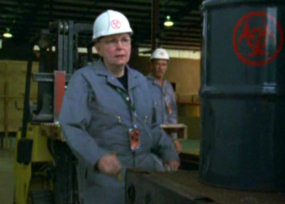Mr. Hell (2006) from Johnny Web (Uncle Scoopy; Greg Wroblewski) |
|
It's not always easy to predict which new releases will be treasured by the ages. As I recall, Roger Ebert gave quite a poor review and one and a half stars to The Usual Suspects, which is now a strong contender for the #1 spot of all time at IMDb. One thing we can safely say, however, is that the super-intelligent beings who rule our planet in the future will have to look back and say of us, "They were flawed beings in many ways, but we can forgive them all their trespasses for having given us Mr. Hell." Mr. Hell was made in Houston, Texas by a first-time director, with a combination of amateur actors and grade-C professionals. The team's inexperience results in some bad moments in the film, but some interesting IMDb pages. Tony Welch, for example, has been forever immortalized in his one and only acting credit as "dead lawyer in drainpipe." Mr. Hell (Harry Eugene Loveless - H.E.L. - get it?) drifts from town to town using menial jobs to support his alternate lifestyle, which basically consists of murdering people and cutting their eyes out. He met his demise early in the film when he was chasing a precocious child through some industrial tunnels and was saturated with toxic acid, thus converting him to liquid form. His liquid remains were stored in a toxic waste container for fourteen years until some clumsy workers spilled him on the floor and brought him back to life. He somehow managed to re-form into human shape, except this time with super-human strength and speed. Since the precocious girl is now working as a security guard in the same laboratory and warehouse complex where Señor Hell had melted, you would think that the movie would proceed to a suspenseful confrontation between them through miles of spooky, abandoned industrial tunnels. You would be wrong. You see, Mr. Hell chose to come back to life on the very day in which some mercenaries decided to attack the place and steal a deadly biological weapon which had been hidden there for years. The bad guys planned to lift the deadly compound and sell it to Osama or Dr. Evil for ... one zillion dollars. Huh? Mercenaries? Terrorists? Former liquids now solidified with super-powers? So just what occupies the heart and soul of this movie? Most of the action centers around the battle between the revitalized Mr. Hell and the scumbag mercenaries! There is a good reason why Vince McMahon rarely pits baddies against each other: to do so minimizes audience involvement. Am I supposed to care when Mr. Hell brutalizes the baddies? Am I supposed to root for him to pulverize them, or do I want them to blow him to bits? I don't know. I didn't much care either way. Lack of viewer involvement is only one of the film's problems. Mr. Hell is a failure on almost every level. The slasher himself simply looks like one of those homeless guys who live beneath the interstate overpasses, more pathetic than scary. The editing strips away many possible opportunities for taut suspense. Some of the acting consists of people who seem to be pausing to remember their lines while talking to other people who seem to be doing local furniture store ads by reading from cue cards. The dialogue consists of lines like, "You are fuckin' with the wrong fuckers." The soundtrack sounds like the tune-up sessions for our neighborhood garage band. One of the special effects scenes looks like an old Windows 95 screensaver. The film does have some funny scenes, but I'm not sure the laughs were intentional. At one point, for example, Mr. Hell and one of the mercenaries have a knife fight, but instead of jabbing, slashing, and thrusting as men normally do with knifes, they make like Errol Flynn and Basil Rathbone and conduct a choreographed blade-on-blade swordfight - although their "swords" are only a few inches long! It looks hilarious. Was the humor intentional? Your guess is as good as mine. Leaving that in the "questionable" column, there are some genuine positives. The photography is competent (it seems to have been shot on 35mm), Larry Cashion is not bad at all as Mr. Hell, and they came up with some suitably creepy locations. |
|
|
It's well known in the world of bad movies that Manos: the Hands of Fate was the first (and last) film made by Hal Warren, a man who decided to change careers late in life from fertilizer salesman to writer-director-actor. Mr. Hell has a similar back-story. The director of the film, Rob McKinnon, appears to be about 60 years old (he has a small part in the film - picture to the right) and is making his directorial debut in feature-length entertainment, if I may use the "e" word in referring to this film. He is probably best known, if at all, as a drive-time morning radio host for Houston's KENR, but he has written and directed various corporate films and news documentaries over the years, and has written his own music for these productions. His IMDb bio says he is a Renaissance man, which might lead one to speculate that he is claiming to know as much about filmmaking as they did in the Renaissance, but I presume it to mean that he has mastered many different fields and disciplines. It's safe to say that his fields of alleged mastery must include painting cathedral ceilings, roasting suckling pigs, composing Spenserian sonnets or some other Renaissance-type activities, because they don't seem to include film direction, as evidenced by Mr. Hell. |
 |
|
Of course, Mr. McKinnon cannot be compared directly to Hal Warren of Manos fame, mainly because McKinnon never sold any fertilizer. But he sure produced some. |
|
|
||||
|
||||
